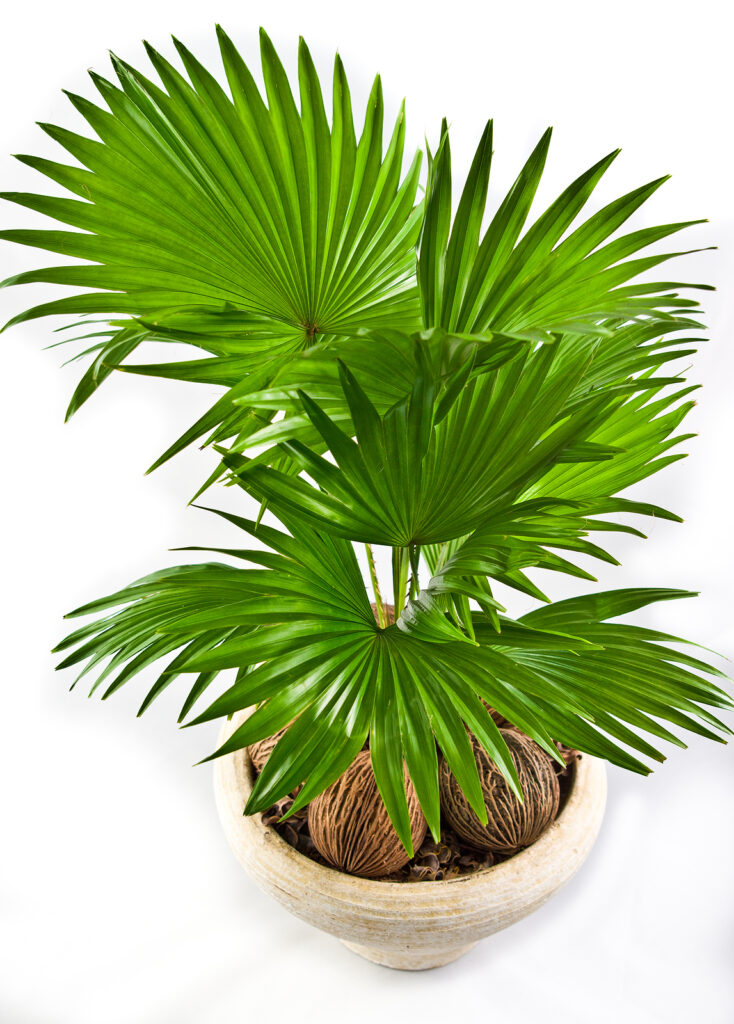Livistona–commonly called Chinese fan palm–is a tropical palm with fan-shaped leaves that are borne in dense, terminal heads. Livistona is grown as a specimen tree in tropical regions; in temperate regions, it is grown as a houseplant.
Livistona has fan-shaped, glossy, rich green leaves with short spiny leaf stalks; the leaves are divided into pendent segments. The fronds are deeply cleft into long, narrow leaf segments that droop at the tips.
Livistona is a genus of about 28 species of single-stemmed palms. Livistona is native to tropical woodland and rainforest in Asia and Australia.
Get to know Livistona
- Plant type: Palm
- Growing zones and range: Zones 11-15
- Hardiness: Tender
- Height and width: 6 to 8 feet (1.8-1.4m) tall grown indoors; outdoors in tropical regions to 40 feet (12m) tall and 15 feet (5m) wide
- Foliage: Fronds artr fan-shaped and deeply cleft into long, narrow leaf segments that droop at the tips.
- Flowers: 3-petaled fleors are produced in panicles
- Bloom time: Summer
- Uses: Houseplant, grow as a specimen tree in tropical regions
- Common name: Chinese fan palm
- Botanical name: Livistona
- Family name: Arecaceae
- Origin: Asia and Australasia

Where to plant Livistona
- Light indoors: Grow Livistona indoors in full or bright indirect light.
- Light outdoors: Grow Livistona outdoors in full sun or partial shade.
- Soil indoors: Grow Livistona in a soil-based pitting mix.
- Soil outdoors: Plant Livistona in humus-rich, well-drained soil.
When to plant Livistona
- Set container-grown Livistona outdoors in tropical or subtropical region any time of the year.
Planting and spacing Livistona
- Space Liviston planted outdoors 15 to 25 feet (5-8m) apart.
How to water and feed Livistona
- Water Livistona freely during the growing season; in winter, water Livistona sparingly.
- Fertilize Liviston with a balanced liquied fertilizer montly during the growing season.
Livistona care
- Water Livistona sparingly in winter and do not apply fertilizer.
Growing Livistona as a houseplant
- Livistona thrives in bright light, average room temperature, and medium humidity.
- The soil can be allowed to dry between waterings.
- Fertilizer should be applied regularly in spring and summer.
- Repotting can be done once every two to three years; use an all-purpose soil mix.
Livistona pests and diseases
- Livistona are susceptible to mealybugs, nematodes, scale insects, and spider mites.
Livistona propagation
- Livistona is best started from seed in a greenhouse; it is very slow growing.
Livistona varieties to grow
- Livistona australis, Australian fan palm. Large palm with erect, robust trunk; long spiny leaf stalks; lustrous deep green fronds often arching at the tips; grows to 80 feet tall and 15 feet wide.
- L. chinensis, Chinese fan palm. Grows to 6 feet tall indoors; leafstalks are 15 inches in length and have sharp spines along the edges; fronds are glossy green, 2 feet land and 2 feet wide; outdoors grows to 40 feet tall and 15 feet wide.
- L. mariae, red fan palm. Grows to 100 feet tall in tropical regions; slimbrunk; spiny leaf stalks.
- L. rotundifolia. Medium to large palm with slim trunk; rounded, lustrous deep green blades, rigid and shallowly notched; grows to 80 feet tall in tropical regions.















